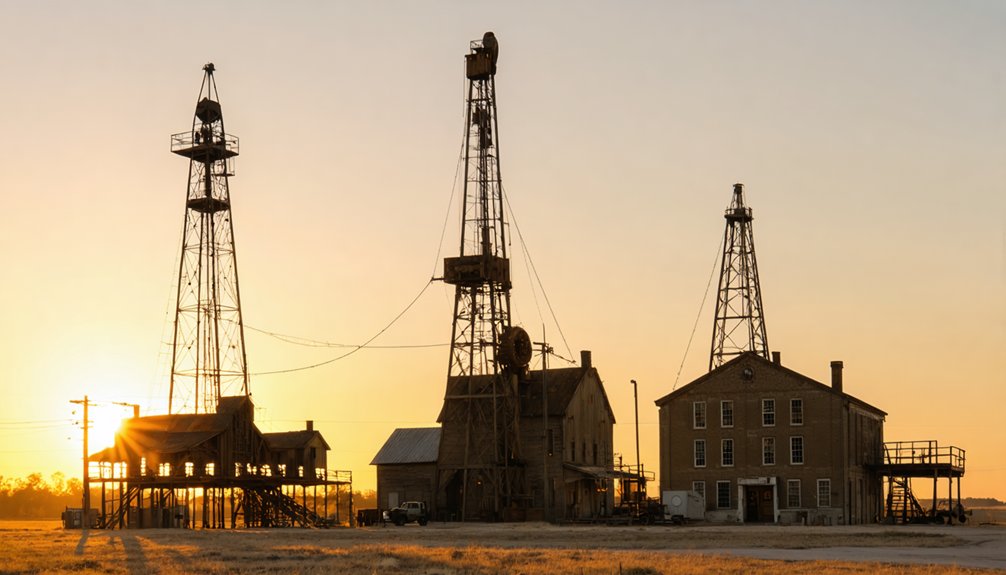You’ll find America’s best-preserved oil industry relics at three iconic sites: Drake Well Museum in Pennsylvania, where the U.S. oil industry began in 1859; Spindletop-Gladys City Boomtown Museum in Texas, commemorating the revolutionary 1901 gusher; and Tulsa’s Art Deco District in Oklahoma, showcasing architectural treasures built with oil wealth after 1905. These historical landmarks preserve both the technological evolution and cultural impact of petroleum’s transformative influence on American communities.
Key Takeaways
- Drake Well Museum in Pennsylvania preserves the birthplace of America’s oil industry with original artifacts and replica structures.
- Spindletop-Gladys City Boomtown Museum in Texas features authentic period buildings commemorating the 1901 Lucas Gusher event.
- Tulsa’s Art Deco District showcases preserved architectural wonders funded by oil wealth in the early 20th century.
- Each site offers unique visitor experiences including historical reenactments, architectural tours, and interactive exhibits.
- These locations have received national historic designations for their cultural significance in preserving America’s petroleum heritage.
Drake Well Museum & Park: Birthplace of the American Oil Industry
Nestled between Pennsylvania Routes 8 and 27 in Venango County’s Cherrytree Township, the Drake Well Museum & Park stands as the undisputed birthplace of America’s oil industry. Here, on August 27, 1859, Edwin Drake struck oil at 69½ feet, triggering Pennsylvania’s oil boom that dominated American production for decades.
You’ll explore 240 acres featuring a board-for-board replica of Drake’s engine house and derrick, with the reconstructed well still pumping recirculated oil. The museum houses 80 professional exhibits showcasing historical artifacts that trace oil drilling evolution from manual to steam power.
The site displays authentic 19th-century equipment including various pump jacks and machinery. Native Americans in the region had long used the natural oil seeps for medicinal purposes before commercial drilling began. The museum’s collection includes over 4,000 artifacts related to the early petroleum industry. This National Historic Landmark offers recreational trails, fishing, and picnic areas—all while preserving the legacy of an industry that transformed global society.
Spindletop-Gladys City Boomtown Museum: Capturing Texas’ Black Gold Rush
While Pennsylvania gave birth to America’s oil industry, Texas changed its scale forever at Spindletop Hill.
At this Beaumont museum, you’ll witness a meticulously reconstructed boomtown that preserves the moment when, on January 10, 1901, the Lucas Gusher shot crude over 100 feet high, launching America’s petroleum age.
Step back in time to witness the gusher that changed American industry forever.
Established in 1976 as a Bicentennial project, this living museum captures authentic Spindletop history through period buildings including a saloon, general store, and post office.
You’ll find original artifacts from the era that transformed Texas into an oil powerhouse. The museum received National Historic Landmark designation for its cultural significance.
Don’t miss the replica wooden derrick and simulated gusher demonstrations that bring this pivotal moment to life.
The oil industry impact is made tangible through historical reenactments by costumed performers who share the dramatic stories of American energy independence. For the best experience, plan your visit during weekday mornings when the museum offers a quieter atmosphere for exploration.
Tulsa’s Art Deco District: Oil Wealth Preserved in Architecture
When wandering through downtown Tulsa, you’ll encounter one of America’s most spectacular concentrations of Art Deco architecture—a magnificent tribute to the city’s explosive oil wealth of the 1920s and 30s.
The discovery of the Glenn Pool oil field in 1905 transformed this Oklahoma city into the “Oil Capital of the World,” financing extraordinary architectural masterpieces.
Along South Boston Avenue, you’ll find the zigzag elegance of the Philtower and Philcade Buildings, funded by oil magnate Waite Phillips and connected by a secret underground tunnel. By the late 1920s, the city boasted nearly 1,500 oil-related companies operating throughout the region.
These structures showcase indigenous Creek motifs, terracotta details, and distinctive Art Deco styling. The Boston Avenue Methodist Church, with its stunning 1929 design, stands as another testament to Tulsa’s architectural golden age.
Since 2010, preservation efforts have secured National Register status for forty buildings in the Oil Capital Historic District, protecting this unique blend of petroleum prosperity and architectural innovation for future generations to explore.
Frequently Asked Questions
How Did Oil Boomtowns Handle Sewage and Waste Management?
You’d find little organized waste disposal in early boomtowns. They lacked sewage systems entirely, with waste dumped directly into streets or waterways, creating hazardous sanitary conditions for residents.
What Entertainment Options Existed for Oil Workers During Boom Periods?
You’d find yourself unwinding at vibrant dance halls, attending local rodeos, enjoying parlor games, watching live bands, participating in sporting events, or catching films at boomtown theaters after your demanding shifts.
How Did Indigenous Communities Respond to Nearby Oil Boom Development?
You’d think oil meant progress, but Indigenous communities fought back through cultural preservation efforts while facing devastating economic impact. They organized political resistance, pursued legal action, and established advocacy movements to protect their sovereignty and lands.
What Environmental Remediation Efforts Exist at Former Oil Boomtown Sites?
You’ll find thorough environmental restoration at former boomtowns through Brownfields initiatives, including site rehabilitation of contaminated soils, groundwater treatment, and UST removal—all aimed at transforming petroleum-polluted properties into safe, usable spaces.
How Did Women Participate in Early Oil Town Economies?
By 1920, women comprised 15% of geology students. You’ll find women’s roles spanned scientific contributions as micropaleontologists, administrative support through the Desk and Derrick Club, and essential service positions in boardinghouses and diners.
References
- https://en.wikipedia.org/wiki/History_of_the_petroleum_industry_in_the_United_States
- https://kuscholarworks.ku.edu/server/api/core/bitstreams/c70129c2-0d0a-4fcb-bd00-5a4eeca1f0ae/content
- https://aoghs.org/petroleum-art/oil-town-aero-views/
- https://repository.library.noaa.gov/view/noaa/36834/noaa_36834_DS1.pdf
- https://experiencetheoilregion.com/heritage-history/
- https://en.wikipedia.org/wiki/Wikipedia:Bot_requests/Archive_29
- https://www.nps.gov/bith/learn/historyculture/oil-gas-industry.htm
- https://ia601409.us.archive.org/24/items/in.ernet.dli.2015.117222/2015.117222.Americas-Historylands_text.pdf
- https://www.talonlpe.com/blog/historic-texas-oil-boomtowns
- https://en.wikipedia.org/wiki/Historic_preservation



